In an unprecedented move, Russian President Vladimir Putin officially rescinded Russia’s ratification of the treaty banning nuclear test explosions anywhere in the world Nov. 2.
Russia’s ratification of the 1996 Comprehensive Test Ban Treaty (CTBT) and the U.S. failure to ratify the treaty “created an imbalance” between the two countries, “which is unacceptable in the current international situation,” said the Kremlin in a statement that day.
U.S. Secretary of State Antony Blinken responded that “Russia’s action will only serve to set back confidence in the international arms control regime,” emphasizing that the United States will continue to adhere to its nuclear test moratorium, which it has observed since 1992.
 Robert Floyd, executive director of the CTBT Organization, called Russia’s move “very disappointing and deeply regrettable” in an Oct. 18 statement.
Robert Floyd, executive director of the CTBT Organization, called Russia’s move “very disappointing and deeply regrettable” in an Oct. 18 statement.
With 187 signatories, the CTBT has not yet entered into force, waiting upon the ratification by eight treaty-specified states, which include China and the United States. Russia ratified the agreement in 2000.
Moscow has remained vague on whether it plans to conduct a nuclear test following its de-ratification of the treaty and stated that it will not resume nuclear testing unless Washington does so first. Russia has also expressed its intention to continue adhering to the nuclear testing moratorium and operating treaty monitoring stations on its territory.
“I am not ready to tell you right now whether we need or do not need to carry out these tests,” said Putin Oct. 5. “What we can do is act just as the United States does.”
Russia’s decision followed the revelation of new construction at China’s Lop Nur nuclear test site, Russia’s Novaya Zemlya nuclear test site, and the U.S. Nevada nuclear test site in a Sept. 22 CNN report.
The construction activities of concern at these sites include “new tunnels under mountains, new roads and storage facilities, as well as increased vehicle traffic coming in and out of the sites,” CNN reported.
Russian Foreign Minister Sergey Ryabkov alleged Oct. 10 that “The indications are that there is or was, at least until recently, (preparatory) work underway at the Nevada Testing Site.”
A U.S. State Department spokesperson denied the allegation, calling it “a disturbing effort by Moscow to heighten nuclear risks and raise tensions in the context of its illegal war in Ukraine.”
The U.S. Energy Department has extended an invitation to international observers to the Nevada test site, where they would be able to take radiation measurements and review data to ensure the U.S. experiments are conducted within permissible limits.
“We are committed to our nuclear-testing moratorium,” said Corey Hinderstein, a senior nonproliferation official at the National Nuclear Security Administration, a semiautonomous agency to the Energy Department. “We have no problem with proving it.” —SHANNON BUGOS and MOHAMMADREZA GIVEH
For more information on Russia’s de-ratification of the CTBT, see: “Russia ‘Deratifies’ Nuclear Test Ban Treaty,” by Shizuka Kuramitsu, Arms Control Today, November 2023
For more on proposals for confidence-building measures at former nuclear test sites, see:
“Reducing Tensions Over Nuclear Testing at Very Low Yield,” by Julien de Troullioud de Lanversin, Christopher Fichtlscherer, and Frank N. von Hippel, Arms Control Today November 2023
“Managing an Arsenal Without Nuclear Testing: An Interview With Jill Hruby of the U.S. National Nuclear Security Administration,” Arms Control Today, December 2023
U.S.-China Talk Arms Control
The United States and China held “candid,” “in-depth,” and “constructive” arms control talks Nov. 6. U.S. President Joe Biden and Chinese President Xi Jinping engaged on the topic when they meet in person Nov. 15.
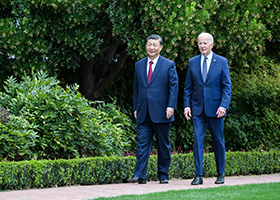 The one-day meeting held between Mallory Stewart, assistant secretary of state for the Bureau of Arms Control, Deterrence, and Stability, and Sun Xiaobo, director-general of arms control in the Chinese Foreign Ministry, was a continuation of “efforts to responsibly manage the relationship and ensure competition does not veer into conflict,” according to the State Department.
The one-day meeting held between Mallory Stewart, assistant secretary of state for the Bureau of Arms Control, Deterrence, and Stability, and Sun Xiaobo, director-general of arms control in the Chinese Foreign Ministry, was a continuation of “efforts to responsibly manage the relationship and ensure competition does not veer into conflict,” according to the State Department.
“I wouldn’t say we learned anything new from [the Chinese delegation] or that they delved into a great amount of detail regarding their nuclear force,” a State Department official commented Nov. 6.
Wang Wenbin, a Chinese Foreign Ministry spokesperson, said that during the meeting, “China elaborated on its position and policies on arms control and nonproliferation issues.”
These talks followed a meeting between Chinese Foreign Minister Wang Yi and National Security Advisor Jake Sullivan in October. Ahead of the upcoming Biden-Xi meeting, the Chinese Foreign Ministry encouraged Oct. 30 that the “two sides should work to stabilize the China-US relationship from further deterioration and bring it back to the track of sound and stable development at an early date.”
Biden and Xi met on the sidelines of the Asia-Pacific Economic Cooperation summit Nov. 15. “The two leaders agreed that their teams will follow-up on their discussions in San Francisco with continued high-level diplomacy and interactions, including visits in both directions and ongoing working-level consultations in key areas," such as arms control, according to a White House statement.
The meetings come as the U.S. Defense Department released Oct. 19 its annual assessment of China’s military, including its nuclear forces.
The Pentagon estimates that China had at least 500 nuclear warheads by May 2023, a number that will “probably” increase to more than 1,000 by 2030.
“What they’re doing now, if you compare it to what they were doing about a decade ago, it really far exceeds that in terms of scale and complexity,” a senior U.S. defense official told The Washington Post Oct. 19.
Chinese Foreign Ministry spokesperson Mao Ning denounced the report, saying that it “ignores the facts, is full of prejudice and spreads the theory of the threat posed by China.”
Russia also defended China. Kremlin spokesperson Dmitry Peskov said Oct. 25 that China’s expanding nuclear arsenal “does not cause us concern.”
“China, which faces very serious challenges for its own security in the region, is taking steps that it considers appropriate,” Peskov added.
For more information on the China military power report, see: “China Continues Nuclear Buildup,” by Carol Giacomo, Arms Control Today, November 2023
NATO Suspends CFE as Russia Withdraws
The North Atlantic Treaty Organization (NATO) announced its suspension of the Conventional Armed Forces in Europe (CFE) Treaty Nov. 7, the same day that Russia’s official withdrawal from the pact took effect.
“While recognizing the role of the CFE as a cornerstone of the Euro-Atlantic security architecture, a situation whereby [NATO members] abide by the Treaty, while Russia does not, would be unsustainable,” said the North Atlantic Council in a Nov. 7 statement. In a decision supported by all NATO states, the alliance therefore intends “to suspend the operation of the CFE Treaty for as long as necessary, in accordance with their rights under international law.”
Signed in 1990, CFE put an equal limit on the quantity of conventional weaponry—to include tanks, armored combat vehicles, heavy artillery, combat aircraft, and attack helicopters—deployed by NATO and the Warsaw Pact countries between the Atlantic Ocean and the Ural Mountains.
In 2007, Moscow declared its “suspension” of the original treaty. Russia first announced in May 2023 that it would formally withdraw from the pact.
“Given the direct responsibility of NATO countries for fueling the Ukraine conflict, as well as the accession of Finland to the alliance and the ongoing consideration of a similar application by Sweden,” said the Russian Foreign Ministry Nov. 7, “even the formal preservation of the CFE Treaty has become unacceptable from the standpoint of Russia's core security interests.”
Meanwhile, the U.S. State Department commented that the “suspension of CFE obligations will strengthen the Alliance’s deterrence and defense capacity by removing restrictions that impact planning, deployments, and exercises.”
Russia Contemplates U.S. Arms Control Proposal
The United States sent Russia an official written arms control proposal in September, about three months after initially stating it would do so.
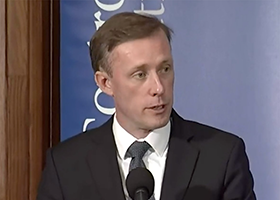 The Biden administration prepared the proposal in September. The proposal reflected U.S. National Security Advisor Jake Sullivan’s speech in June at the Arms Control Association’s annual meeting and “added additional details,” Pranay Vaddi, senior director for arms control, disarmament, and nonproliferation at the U.S. National Security Council, told the Russian newspaper Kommersant Nov. 3.
The Biden administration prepared the proposal in September. The proposal reflected U.S. National Security Advisor Jake Sullivan’s speech in June at the Arms Control Association’s annual meeting and “added additional details,” Pranay Vaddi, senior director for arms control, disarmament, and nonproliferation at the U.S. National Security Council, told the Russian newspaper Kommersant Nov. 3.
A senior Biden administration official noted a few days prior that Washington is aiming to start “a conversation on what a framework after New START could look like,” referring to the 2010 treaty set to expire in February 2026.
“Russia has not responded to it, but [Russian Deputy Foreign Minister Sergei] Ryabkov said Russian authorities are working on a response,” Vaddi added.
However, Kremlin spokesperson Dmitry Peskov has cast doubts on the prospect for U.S.-Russian arms control talks. “Dialogue is unequivocally necessary,” he said Nov. 8. “And we are certainly ready to start it. But so far, the actual situation has not changed in any way.”
Meanwhile, Russian Security Council Secretary Nikolai Patrushev touted Nov. 6 that, “For the first time in the history of the existence of nuclear weapons, our country is ahead of its competitors in the [nuclear] domain.”
U.S. Announces Unexpected New Nuclear Warhead Variant
The U.S. Defense Department unexpectedly announced its intention to pursue an additional variant of the B61 nuclear gravity bomb, to be known as the B61-13, in October.
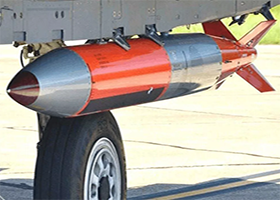 “Today’s announcement is reflective of a changing security environment and growing threats from potential adversaries,” said Assistant Secretary of Defense for Space Policy John Plumb in an Oct. 27 statement. “The United States has a responsibility to continue to assess and field the capabilities we need to credibly deter and, if necessary, respond to strategic attacks, and assure our allies.”
“Today’s announcement is reflective of a changing security environment and growing threats from potential adversaries,” said Assistant Secretary of Defense for Space Policy John Plumb in an Oct. 27 statement. “The United States has a responsibility to continue to assess and field the capabilities we need to credibly deter and, if necessary, respond to strategic attacks, and assure our allies.”
The B61-13 variant would have a maximum yield similar to the B61-7 variant of 360 kilotons, a massive increase as opposed to the most recent B61-12 variant, which has a yield of 50 kilotons. The new variant would be “deliverable by modern aircraft” and provide “the President with additional options against certain harder and large-area military targets,” the department stated.
The development of the B61-13 will not increase the size of the U.S. nuclear arsenal, the Pentagon noted in a fact sheet published Oct. 27. “The number of B61-12s to be produced will be lowered by the same amount as the number of B61-13s produced,” it said.
The fact sheet also directly tied the decision to develop the B61-13 to the Biden administration’s effort to retire the megaton B83 gravity bomb, which has faced significant pushback from Congress.
In an Oct. 27 blog post, the Federation of American Scientists said that what appears to have occurred is that, “after defense hardliners blocked the administration’s plans to retire the B83-1, the administration likely agreed to retain the B61-7 yield in the stockpile in the form of a modern bomb modification (B61-13) that is easier and cheaper to maintain, so that they can finally proceed with the retirement of the B83-1.”
The Energy Department officially requested in an Oct. 24 letter to Congress to amend its fiscal year 2024 budget request to allow for B61-13 development engineering activities to begin.
Russia, NATO Hold Simultaneous Annual Nuclear Exercises
Russia and the North Atlantic Treaty Organization (NATO) held their respective annual nuclear exercises in October.
NATO’s exercise, known as Steadfast Noon, began Oct. 16 for 10 days. This year, the exercises included the participation of 13 NATO countries and a mix of more than 60 aircraft, such as fighter jets and U.S. B-52 bombers, taking part in training flights over Italy, Croatia, and the Mediterranean Sea.
“The exercise involves fighter aircraft capable of carrying nuclear warheads, but does not involve any live bombs,” assured the alliance in a statement Oct. 13. “The exercise is not linked to current world events and the bulk of the training is held at least 1,000 kilometers from Russia’s borders.”
Russia launched its annual nuclear exercise, known as Grom, Oct. 25.
“Putin led a training exercise that involved the forces and resources of the ground, sea, and air components of Russia’s nuclear deterrence forces,” said the Kremlin in a statement that day. “The exercise included practical launches of ballistic and cruise missiles.”
Russian Defense Minister Sergei Shoigu said that this year’s exercise involved “delivering a massive nuclear strike by strategic offensive forces in response to an enemy nuclear strike.”
In comparison to previous Grom exercises, the 2023 exercise was relatively scaled down, according to Russian nuclear expert Dmitry Stefanovich.
In addition, Russia has continued the development of new nuclear weapon delivery systems.
Putin confirmed reporting in early October that Russia conducted a test of the nuclear-armed, nuclear-powered cruise missile, dubbed the Burevestnik. He called it a success.
Putin also disclosed that the new heavy intercontinental ballistic missile, the Sarmat, is ready for deployment. “All we have left is to complete all the administrative and bureaucratic procedures and paperwork so that we can move to mass production and deploy it in combat standby mode,” he said.
Matt Korda and Hans Kristensen of the Federation of American Scientists, however, doubt that the Sarmat will be deployed soon.
“It is potentially possible that one or two missiles could be deployed early,” they wrote in an Oct. 19 blog post, “but major construction is still ongoing at many of the silos in the first regiment and has not yet begun at all of them, and the completion of construction at all eventual Sarmat regiments may be over a decade away.”
Increased U.S. Nuclear Arsenal Necessary, Says U.S. Expert Panel
The United States must plan to increase the size of its nuclear arsenal to adequately counter China and Russia, a Congressionally appointed commission recommended in a report published Oct. 12.
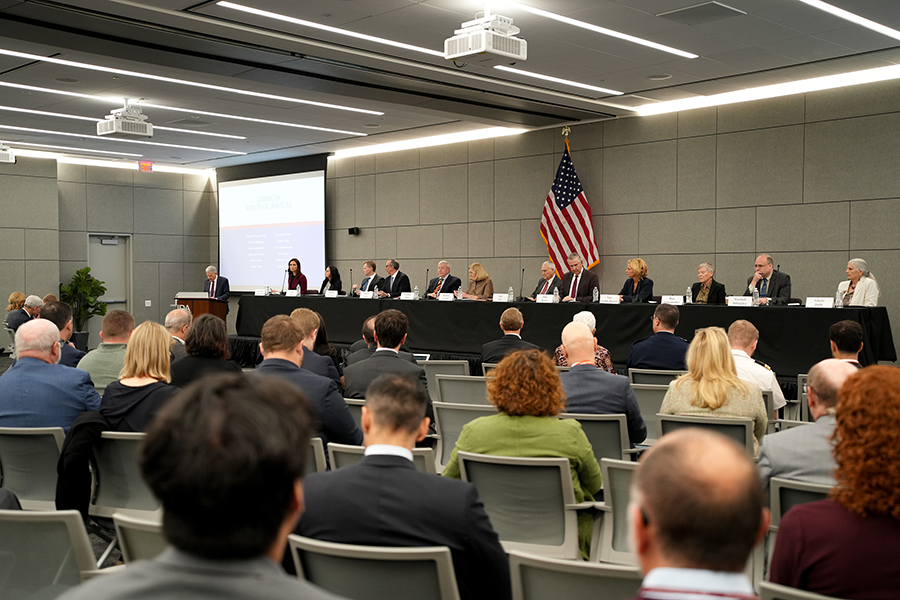 “The United States lacks a comprehensive strategy to address the looming two-nuclear-peer threat environment and lacks the force structure such a strategy will require,” stated the report by the Strategic Posture Commission.
“The United States lacks a comprehensive strategy to address the looming two-nuclear-peer threat environment and lacks the force structure such a strategy will require,” stated the report by the Strategic Posture Commission.
“The size and composition of the nuclear force must account for the possibility of combined
aggression from Russia and China,” stated the report, advising that the U.S. nuclear arsenal must be “either larger in size, different in composition, or both.”
An unnamed senior official involved in the report told Reuters “We worry…there may be ultimate coordination between them in some way, which gets us to this two-war construct.”
Russian President Vladimir Putin dismissed the commission’s report Oct. 15, saying that “to fight with both Russia and China, it is nonsense. I don’t think it is serious.”
Putin added, “And if they want to fight with Russia then it will be a completely different war. It will not be carrying out a special military operation.”
The commission consisted of 12 experts chosen by Democrat and Republican members of Congress, who tasked the experts with evaluating and making recommendations for the U.S. strategic posture from 2027 through 2035.
Sens. Angus King (I-Maine) and Deb Fischer (R-Neb.), the chair and ranking member of the Senate Armed Services Strategic Forces subcommittee, embraced the report. “We understand the need for a nuclear force posture that can successfully deter adversaries in a worsening global threat environment,” they said in a joint statement Oct. 17. “We look forward to continuing conversations with the Commissioners on their findings and options to strengthen our national defense.”
The commission’s recommendations for changes to the U.S. nuclear force posture include:
- Prepare to upload some or all hedge warheads in storage,
- Plan to deploy the new intercontinental ballistic missiles (ICBMs), known as the Sentinel system, with more than one warhead,
- Increase the planned number of deployed new air-launched cruise missiles, known as Long-Range Standoff Weapons,
- Increase the planned number of B-21 strategic bombers, and
- Increase the planned production of Columbia-class submarines and the accompanying submarine-launched ballistic missiles, known as Trident missiles.
The commission advises subjugating arms control to such changes in the U.S. nuclear arsenal. “A strategy to address the two-nuclear-peer threat environment be a prerequisite for developing U.S. nuclear arms control limits for the 2027-2035 timeframe.”
An analysis by the Federation of American Scientists concluded that, in other words, “this constitutes a recommendation to participate in an arms race, and then figure out how to control those same arms later.”
“Obviously the report is very hard edged,” Rose Gottemoeller, chief U.S. negotiator of New START and member of the commission, told The Wall Street Journal. “It is possible to turn away from these threats and these eventualities should the overall environment change.”
For further analysis of the Strategic Posture Commission’s report, see: “A Not-So-Strategic Posture Commission,” by Adam Mount, Arms Control Today, November 2023
Pentagon Issues Updated Counter-WMD Strategy
The U.S. Defense Department published its revised strategy for countering weapons of mass destruction (WMD) in September, which centers around countering the “pacing” challenge from China and defending against the persisting threat from Russia, Iran, and North Korea.
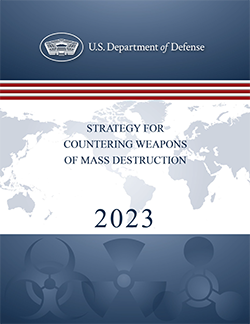 “This Strategy reinforces other guidance provided in the Nuclear Posture Review, the Missile Defense Review, and the Biodefense Posture Review by clarifying the role of the CWMD mission within the Department’s overall approach to integrated deterrence and conflict,” said Defense Secretary Lloyd Austin in the document’s forward.
“This Strategy reinforces other guidance provided in the Nuclear Posture Review, the Missile Defense Review, and the Biodefense Posture Review by clarifying the role of the CWMD mission within the Department’s overall approach to integrated deterrence and conflict,” said Defense Secretary Lloyd Austin in the document’s forward.
The Pentagon’s strategy lays out four countering WMD-specific priorities: defending the homeland from WMD attacks; deterring WMD use against the United States and its allies and partners; enabling the joint force to prevail in an environment where chemical, biological, radiological, and nuclear threats are contested; and preventing new WMD threats.
The strategy insists upon “an integrated approach along with military, diplomatic, and economic instruments of power” in order to attempt to change adversaries’ decision calculus. The document also recognizes emerging technologies—such as big data, artificial intelligence, and multi-domain WMD misinformation pursuits—as new exacerbating elements in counter-WMD activities.
The last iteration of this document published in 2014 focused on “counterterrorism and counterinsurgency operations [and prioritized] managing WMD risk emanating from hostile, fragile or failed states and safe havens.” The 2023 strategy is the Pentagon’s third version iteration.
For more information on the Pentagon’s strategy to counter WMD, see: “A New U.S. Strategy Against WMD Threats,” by Mohammadreza Giveh, Arms Control Today, November 2023
In Case You Missed It
- “The U.S. and China re-engage on arms control. What may come next,” by Daryl G. Kimball, Bulletin of the Atomic Scientists, Nov. 15
- “Report on Deterrence in a World of Nuclear Multipolarity,” by the Secretary of State’s International Security Advisory Board, Nov. 15
- “The New Nuclear Age,” by various authors, Scientific American, Nov. 14
- “More Than Just Nuclear: Risk Reduction in the China-US Relationship,” by Fiona Cunningham, The Diplomat, Nov. 10
- “The Pentagon wants a new powerful nuclear bomb. Please don't give it to them,” by Rae Hodge, Salon, Nov. 7
- “Why the US fixation on increased nuclear capability won’t deter China but could lead to instability and nuclear war,” by Andrew Facini, Bulletin of the Atomic Scientists, Oct. 27
- “We Are Sleepwalking Into a New Nuclear Arms Race,” by Ankit Panda, The New Republic, Oct. 24
- “Strategic Posture Review: Echoes of Dr. Strangelove,” by William Hartung, Responsible Statecraft, Oct. 16
- “The U.S. Nuclear Arsenal Can Deter Both China and Russia,” by Charles L. Glaser, James M. Acton, and Steve Fetter, Foreign Affairs, Oct. 5
